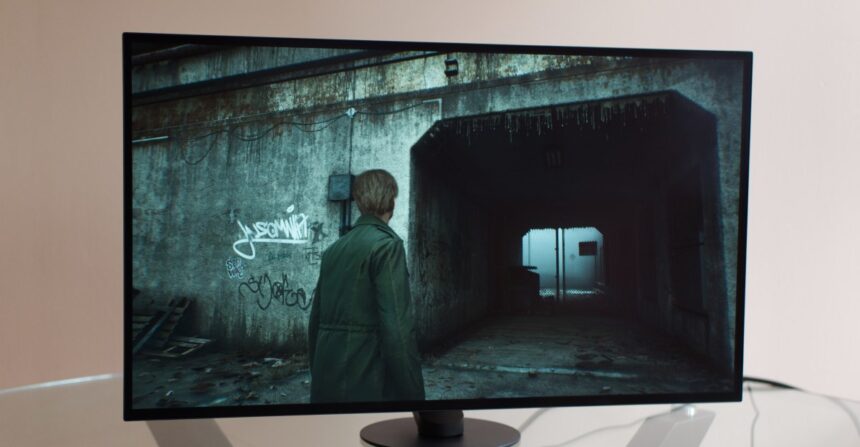Update: Sony clarified that its one-year warranty covers burn-in.
Just as 27-inch 1440p OLED gaming monitors are catching on with more PC gamers thanks to a steady reduction in price, Sony is throwing a curveball with its first OLED monitor, the $1,099.99 InZone M10S. The M10S retains the unparalleled contrast and stellar picture quality that OLED is known for, but rather than join the ranks with the commonly used 240 Hz refresh rate, it’s raising the bar with 480 Hz instead.
The increased refresh rate is the M10S’ distinguishing hardware feature, and it’s a big selling point if you’re a competitive PC gamer who wants cutting-edge tech to improve your performance. (The 0.03-millisecond response time, conversely, is more in line with current industry standards for OLED monitors.) Paired with a fast enough GPU, the M10S can run a batch of online multiplayer games including Counter-Strike 2, Fortnite, Overwatch 2, Valorant, and more at 1440p resolution up to 480 frames per second. That might sound excessive, or perhaps intangibly fast, but it’s a worthwhile upgrade for people who play these games at a competitive level. The M10S is one of two monitors out there that supports 480 Hz at 1440p, the other being a $999 Asus monitor.

Photo: Cameron Faulkner/todayeducationnews
I spent some time putting the 480 Hz mode to the test with my Windows PC playing Counter-Strike 2. The game instantly set the refresh rate to 480 Hz, though even with all of the settings turned down, my Nvidia RTX 3070 Ti-powered machine struggled to maintain a steady 290 frames per second at 1440p resolution. It was an enjoyable experience nevertheless, although I personally didn’t notice a major difference at 480 Hz compared to 240 Hz.
The value of the M10S’ fast refresh rate and response time are pretty obvious for pros, but it’s questionable for casual players who don’t have a powerful gaming PC or a passion for playing competitively. Even for those who are well equipped, large swaths of games don’t support such a fast refresh rate. To put a finer point on it, if you’re not spending most of your time pushing its refresh rate to the max, then you’re not going to see a major difference between the M10S and a more moderately priced OLED gaming monitor.
Photo: Cameron Faulkner/todayeducationnews
I’ve adored playing horror games on the M10S, even if they’re not the speedy, high refresh rate titles that take full advantage of its features. I’ve been meaning to get through the Separate Ways DLC for the Resident Evil 4 remake as well as the Dead Space remake, and those are just the kinds of games that the M10S and other OLEDs do best. With HDR turned on, the games’ dark scenes look bold and appropriately haunting. And since Halloween is getting close, I also played the Silent Hill 2 remake after connecting the M10S to my PS5. For PS5 and Xbox Series X, the frame rate tops out at 120 Hz for supported games, even though many console games struggle to reach a steady 60 frames per second. The M10S doesn’t have built-in speakers, but that’s not a con for me; I’d rather listen to game audio through my headphones anyway.

Photo: Cameron Faulkner/todayeducationnews
Sony co-developed the M10S with gaming pros Fnatic to make it the preferred choice among hair-splitting esports athletes. The hope is that more of them will value OLED’s unique combination of speed, great viewing angles, and pixel-perfect color accuracy over TN LCD panels. TN panels are the fastest panels around, peaking at a 540 Hz refresh rate but with worse all-around picture quality. To that end, Sony devised some clever ways to appeal to its target audience of competitive gamers, including the ability to shrink the M10S’ display to 24.5 inches, a popular size among professionals, with black bars around its sides. And, for those who are making the transition to OLED, Sony’s monitor features the FPS Pro visual preset, which ironically alters the appearance of the OLED to mimic the TN panel they might be accustomed to, but without the added response time that comes with gaming on one. These features don’t mean much to me, but I imagine they’re a big deal for some gamers.
Outside of the product itself, I had concerns about the M10S’ one-year warranty, which YouTube channel BadSeed Tech’s review pointed out didn’t mention burn-in protection. However, Sony confirmed to todayeducationnews that panel burn-in is, and has always been, covered as part of its one-year warranty. The company now mentions it in the monitor’s FAQ under the “Troubleshooting” section.
If you’re a casual gamer, I already noted that I think you should opt for a less expensive OLED gaming monitor, many of which come close enough to matching the M10S’ specs. Heck, you can find OLED monitors up to 39 inches in size for less than $1,000. After reviewing Sony’s first gaming monitor in 2022, I said that it was good, but not nearly good enough for the price. Unless you’re a pro who will get the most out of the M10S’ 480 Hz refresh rate, I unfortunately feel the same here about the M10S. It’ll be easier to recommend at a lower price, but I’m more comfortable directing competitive gamers to Asus’ competing 480 Hz 1440p monitor that has a 3-year warranty that protects against burn-in (compared to Sony’s one-year of coverage), or save even more with a 240 Hz monitor.












